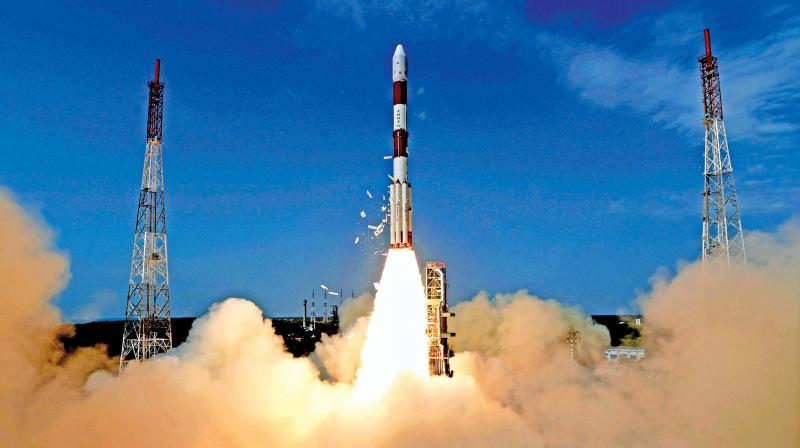Cartosat-2E, 30 satellites placed in orbit

SRIHARIKOTA: Following the 28-hour countdown activities, the PSLV rocket lifted off from the first launch pad of Satish Dhawan Space Centre at 9.29 am. After a flight of 24 minutes, the rocket laced the 712-kg Cartosat-2 series satellite and co-passenger satellites weighing 243 kg into their Sun Synchronous Orbit (SSO). The highly reliable launch vehicle has registered 39th consecutive success in its 40th mission.
Congratulating the scientists, Isro chairman A.S Kiran Kumar said, “The space organisation will launch the GSAT-17 communication satellite on June 28 which will increase the transponder capacity significantly. Our efforts to increase the navigation, earth observation and communication satellites will continue.” “Starting from May 5, Isro has sent three different missions in a short span of 50 days. We have launched South Asian Satellite, communication satellite and earth observation satellite with GSLV Mk-II, GSLV-MK-III and PSLV rockets,” said K. Sivan, director, Vikram Sarabhai Space Centre, Thiruvananthapuram
“PSLV-C38 rocket is not a regular mission. We have got some innovation in this mission. After satellite separation, the stage four of the rocket (PS4) will be active for 10 more orbits. It will provide the cost effective platform for carrying out very costly experiments,” he said. In the coming days, the Cartosat-2E satellite will be brought to its final operational configuration following which it will begin to provide various remote sensing services using its panchromatic (black and white) and multispectral (colour) cameras.
The 29 co-passenger nanosatellites are from 14 foreign countries, including Austria, Belgium, Chile, Czech Republic, Finland, France, Germany, Italy, Japan, Latvia, Lithuania, Slovakia, United Kingdom, and the United States of America and one nanosatellite from India. The pictures and videos of Cartosat-2E would be helpful in a wide range of activities including military and civil planning.
IRNSS-1A to be replaced in two months:
After the failure of atomic clocks in indigenous navigation satellite IRNSS-1A, the Indian Space Research Organisation is set to replace it with a new satellite in two months. "The Indian Regional Navigational System (IRNSS) was identified with seven satellites and two spare satellites. We need to use the spares in case of emergency. We will launch this satellite in two months," Isro chairman A.S. Kiran Kumar said. He further said the navigational service is currently available and service is not affected as other six satellites of the
constellation are functioning well. On the interplanetary missions, he said, the space organisation will finalise the plan of action very soon with regards to Mars Orbiter Mission-2, Venus and Asteroid missions. "Right now, Chandrayaan-II and Aditya are the two missions for which we have approvals."
Students satellite to do the agri-crop monitoring:
The students of Noorul Islam University in Kanyakumari district have developed NIUSAT-Mark-1 for monitoring agricultural crop monitoring and for disaster management. The satellite was one among the 30 nanosatellites launched by the PSLV-C38 rocket on Friday. "This is the first three axis nanosatellite using indigenously developed sun sensors, micro reaction wheels. The multispectral camera has the 25-metre resolution and 50 square kilometres are," said M.Krishnasamy, project director, NIUSAT.
"The satellite can give data on daily basis and it can be used for crop monitoring," he said. The satellite is weighing 15 kg. The university also has plans for NIUSAT Mark-II to collect the above environmental data on day to day basis. The proposal is awaiting the Ministry of Environment and Forest's approval.

